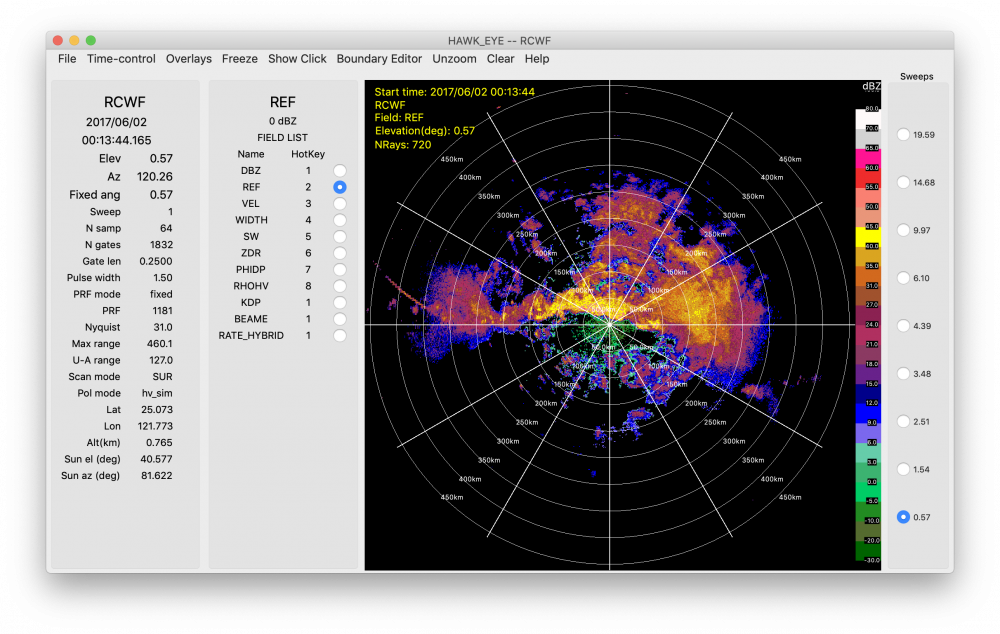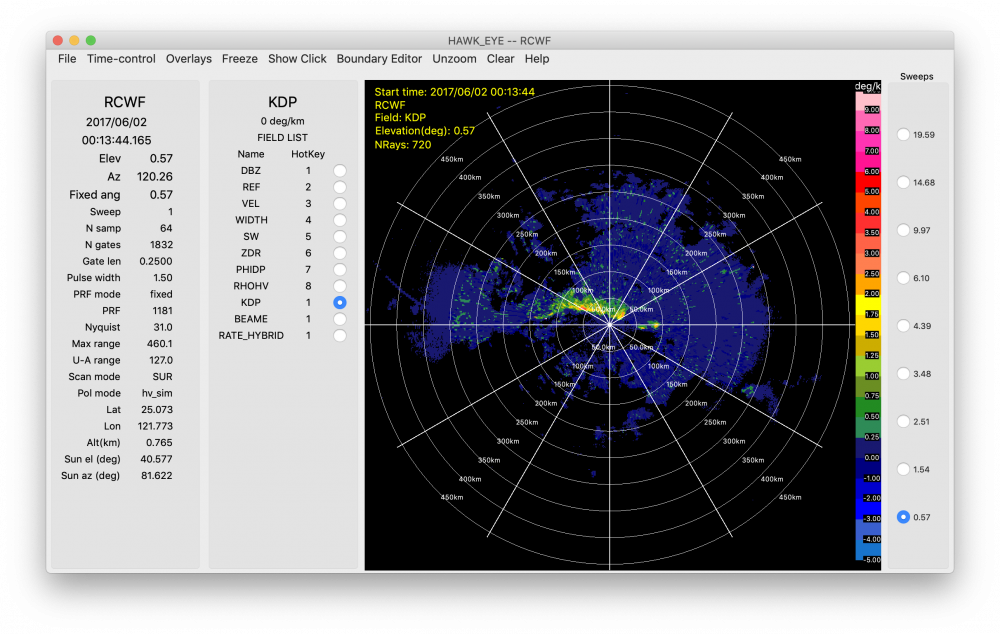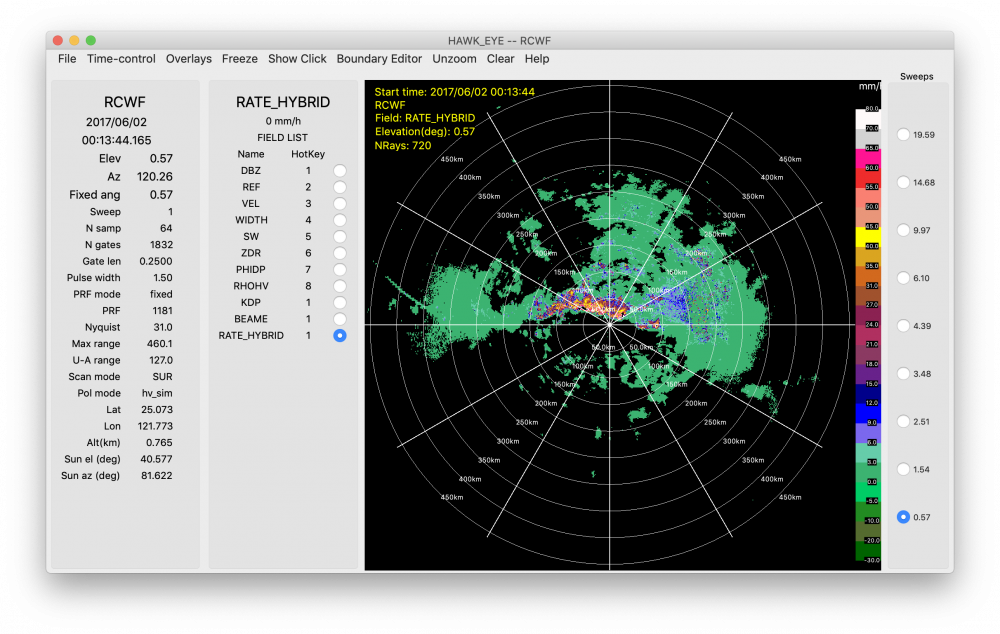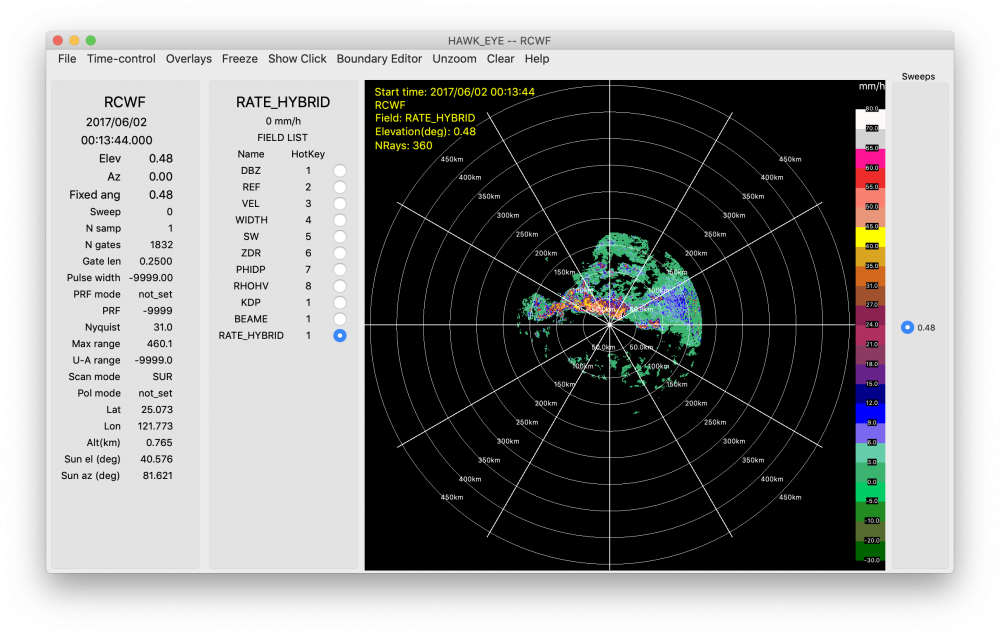Difference between revisions of "Elle basic plus"
From Lrose Wiki
(Created page with " == Basic elle tutorial == This workflow will convert a single raw radar file to the CfRadial format and estimate the surface rain rate. Note, the current parameter files are...") |
|||
| Line 1: | Line 1: | ||
| − | == Basic elle tutorial == | + | == Basic+ elle tutorial == |
| − | + | Like the basic elle tutorial, this workflow will convert a single raw radar file to the CfRadial format and estimate the surface rain rate, with the added tasks of estimating the sounding at the radar from GFS analysis and running RadxBeamBlock. Note, the current parameter files are currently optimized to work on Unix systems. This workflow is one way to test that the applications have been installed properly. | |
=== Run each program one by one on the command line === | === Run each program one by one on the command line === | ||
<ol start="1" style="list-style-type: decimal;"> | <ol start="1" style="list-style-type: decimal;"> | ||
| − | <li>Download the [https://drive.google.com/file/d/ | + | <li>Download the [https://drive.google.com/file/d/1FnxZMv1cmr6enP9S9nU-bqYLynq05OtU/view?usp=sharing elle_sound_bb.tar.gz] file</li></ol> |
<ol start="2" style="list-style-type: decimal;"> | <ol start="2" style="list-style-type: decimal;"> | ||
<li>Extract contents into the desired directory</li></ol> | <li>Extract contents into the desired directory</li></ol> | ||
| − | tar -zxvf | + | tar -zxvf elle_sound_bb.tar.gz |
| − | You'll end up with a directory structure that includes files to set environment variables | + | You'll end up with a directory structure that includes files to set environment variables, the raw radar files, and a sample script that will run all the programs in one go. |
[[File:Elle_basic_ls.png|600px]] | [[File:Elle_basic_ls.png|600px]] | ||
<ol start="3" style="list-style-type: decimal;"> | <ol start="3" style="list-style-type: decimal;"> | ||
| − | <li>In / | + | <li>In /elle_sound_bb/env_dirs, edit the directories (note: there is purposely no slash at the beginning of PROJ). Together, HOMED/PROJ should direct you to the elle_basic directory. RAW is the full path to the raw radar data in /elle_sound_bb.</li></ol> |
export HOMED="/path/to/home/directory" | export HOMED="/path/to/home/directory" | ||
| − | export PROJ=“short/path/to/ | + | export PROJ=“short/path/to/elle_sound_bb” |
| − | export RAW="/path/to/ | + | export RAW="/path/to/elle_sound_bb/raw" |
<ol start="4" style="list-style-type: decimal;"> | <ol start="4" style="list-style-type: decimal;"> | ||
<li>Set the variables in the terminal and set the date. Print out the directory structure to make sure it's pointing to the right directory.</li></ol> | <li>Set the variables in the terminal and set the date. Print out the directory structure to make sure it's pointing to the right directory.</li></ol> | ||
| Line 25: | Line 25: | ||
echo $HOMED/$PROJ | echo $HOMED/$PROJ | ||
<ol start="5" style="list-style-type: decimal;"> | <ol start="5" style="list-style-type: decimal;"> | ||
| + | <li>Download the GFS analysis from this [https://www.ncdc.noaa.gov/data-access/model-data/model-datasets/global-forcast-system-gfs website]. Select the AIRS option for the 0.5º domain, which is the first GFS option available. Since the tutorial includes two different files, select all UTC cycles and enter the start and end dates (02 Jun 2017). Select the batch option and enter your email. Download the data when your order is ready and put it in a folder named gfs within the elle_sound_bb directory.</li></ol> | ||
| + | <ol start="6" style="list-style-type: decimal;"> | ||
| + | <li>Download the topography data using the following command for this particular case. FYI: the folder is approximately 6 GB. Unzip the contents and make note of the resulting directory.</li></ol> | ||
| + | wget -r https://dds.cr.usgs.gov/srtm/version2_1/SRTM3/Eurasia/ | ||
| + | <ol start="7" style="list-style-type: decimal;"> | ||
<li>Convert the raw file to a CfRadial file</li></ol> | <li>Convert the raw file to a CfRadial file</li></ol> | ||
/path/to/RadxConvert -params ./params/RadxConvert.* -f $RAW/$RADAR_NAME/$days/*.raw* | /path/to/RadxConvert -params ./params/RadxConvert.* -f $RAW/$RADAR_NAME/$days/*.raw* | ||
| − | <ol start=" | + | <ol start="8" style="list-style-type: decimal;"> |
<li>Run RadxRate to calculate Kdp, the PID, and various rain rates</li></ol> | <li>Run RadxRate to calculate Kdp, the PID, and various rain rates</li></ol> | ||
/path/to/RadxRate -params ./params/RadxRate.* -f ./convert/$RADAR_NAME/$days/*.nc | /path/to/RadxRate -params ./params/RadxRate.* -f ./convert/$RADAR_NAME/$days/*.nc | ||
| − | <ol start=" | + | <ol start="9" style="list-style-type: decimal;"> |
<li>Run RadxQpe to estimate the near-surface rainfall using the hybrid method</li></ol> | <li>Run RadxQpe to estimate the near-surface rainfall using the hybrid method</li></ol> | ||
/path/to/RadxQpe -params ./params/RadxQpe.* -f ./rate/$RADAR_NAME/$days/*.nc | /path/to/RadxQpe -params ./params/RadxQpe.* -f ./rate/$RADAR_NAME/$days/*.nc | ||
| − | <ol start=" | + | <ol start="10" style="list-style-type: decimal;"> |
<li>In the elle_basic directory, you should now see 3 new directories: convert, rate, and qpe. You can look through the the files in those directories to inspect the new files and check the quality of the data.</li></ol> | <li>In the elle_basic directory, you should now see 3 new directories: convert, rate, and qpe. You can look through the the files in those directories to inspect the new files and check the quality of the data.</li></ol> | ||
=== Run programs from a sample script === | === Run programs from a sample script === | ||
<ol start="1" style="list-style-type: decimal;"> | <ol start="1" style="list-style-type: decimal;"> | ||
| − | <li>Follow steps 1-3 from the section above.</li></ol> | + | <li>Follow steps 1-3 and 5-6 from the section above.</li></ol> |
<ol start="2" style="list-style-type: decimal;"> | <ol start="2" style="list-style-type: decimal;"> | ||
<li>Edit directories in run_radx.sh script (lines 3 and 12)</li></ol> | <li>Edit directories in run_radx.sh script (lines 3 and 12)</li></ol> | ||
Revision as of 23:31, 20 August 2020
Contents
Basic+ elle tutorial
Like the basic elle tutorial, this workflow will convert a single raw radar file to the CfRadial format and estimate the surface rain rate, with the added tasks of estimating the sounding at the radar from GFS analysis and running RadxBeamBlock. Note, the current parameter files are currently optimized to work on Unix systems. This workflow is one way to test that the applications have been installed properly.
Run each program one by one on the command line
- Download the elle_sound_bb.tar.gz file
- Extract contents into the desired directory
tar -zxvf elle_sound_bb.tar.gz
You'll end up with a directory structure that includes files to set environment variables, the raw radar files, and a sample script that will run all the programs in one go.
- In /elle_sound_bb/env_dirs, edit the directories (note: there is purposely no slash at the beginning of PROJ). Together, HOMED/PROJ should direct you to the elle_basic directory. RAW is the full path to the raw radar data in /elle_sound_bb.
export HOMED="/path/to/home/directory" export PROJ=“short/path/to/elle_sound_bb” export RAW="/path/to/elle_sound_bb/raw"
- Set the variables in the terminal and set the date. Print out the directory structure to make sure it's pointing to the right directory.
source env_dirs source env_vars export days=“20170602” echo $HOMED/$PROJ
- Download the GFS analysis from this website. Select the AIRS option for the 0.5º domain, which is the first GFS option available. Since the tutorial includes two different files, select all UTC cycles and enter the start and end dates (02 Jun 2017). Select the batch option and enter your email. Download the data when your order is ready and put it in a folder named gfs within the elle_sound_bb directory.
- Download the topography data using the following command for this particular case. FYI: the folder is approximately 6 GB. Unzip the contents and make note of the resulting directory.
wget -r https://dds.cr.usgs.gov/srtm/version2_1/SRTM3/Eurasia/
- Convert the raw file to a CfRadial file
/path/to/RadxConvert -params ./params/RadxConvert.* -f $RAW/$RADAR_NAME/$days/*.raw*
- Run RadxRate to calculate Kdp, the PID, and various rain rates
/path/to/RadxRate -params ./params/RadxRate.* -f ./convert/$RADAR_NAME/$days/*.nc
- Run RadxQpe to estimate the near-surface rainfall using the hybrid method
/path/to/RadxQpe -params ./params/RadxQpe.* -f ./rate/$RADAR_NAME/$days/*.nc
- In the elle_basic directory, you should now see 3 new directories: convert, rate, and qpe. You can look through the the files in those directories to inspect the new files and check the quality of the data.
Run programs from a sample script
- Follow steps 1-3 and 5-6 from the section above.
- Edit directories in run_radx.sh script (lines 3 and 12)
cd /PATH/TO/elle_basic rdir="/PATH/TO/lrose/bin"
- Make the file executable, if it isn't already
chmod u+x run_radx.sh
- Run shell script/li>
./run_radx.sh
- In the elle_basic directory, you should now see 3 new directories: convert, rate, and qpe. You can look through the the files in those directories to inspect the new files and check the quality of the data.
Example output
Shown below are some HawkEye snapshots of data from the files created during each step. Example of the reflectivity field displayed in HawkEye created by RadxConvert.
Example of the Kdp field displayed in HawkEye created by RadxRate.
Example of the hybrid rain rate field displayed in HawkEye created by RadxRate.
Example of the estimated surface rain rate field displayed in HawkEye created by RadxQpe.




